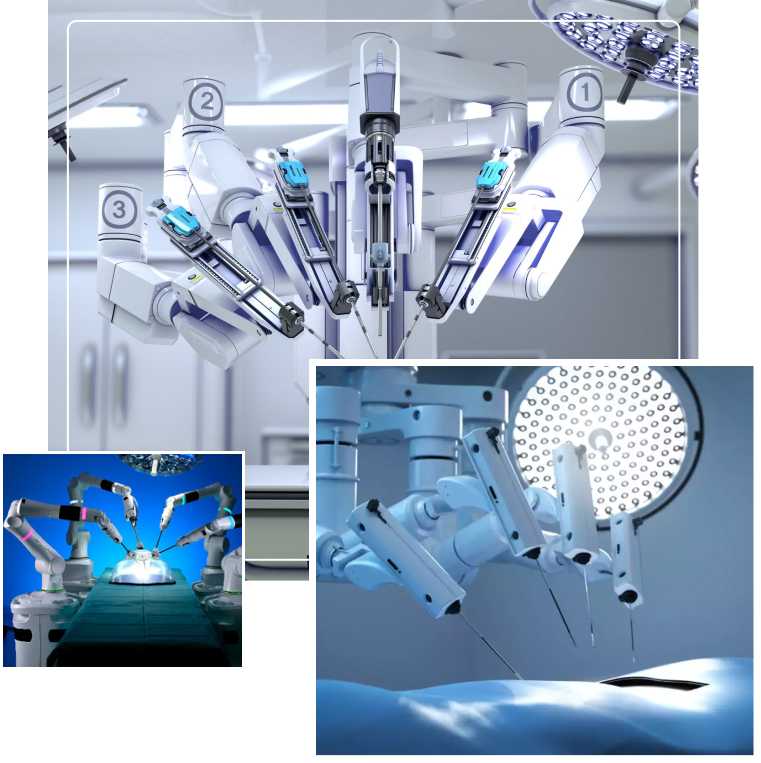
What is Robotic Cancer Surgery?
Types of Robotic Cancer Surgery
- Robotic Prostate Cancer Surgery
- Robotic Surgery for head and neck cancer
- Robotic Surgery for breast cancer
- Robotic Surgery for kidney cancer
- Robotic Surgery for bladder cancer
- Robotic Surgery for uterine cancer
- Robotic Surgery for cervical cancer
- Robotic Surgery for ovarian cancer
- Robotic Surgery for endometrial cancer
When is Robotic Cancer Surgery Needed?
Complex surgeries: Tumours located in difficult-to-reach areas or those requiring intricate procedures benefit from robotic assistance.
Minimally invasive procedures: When preserving organs, nerves, or blood vessels is crucial, robotic surgery’s precision is advantageous.
Improved visualization: Robotic systems provide enhanced 3D imaging, aiding in the identification and removal of tumors.
Faster recovery: Smaller incisions and reduced blood loss result in shorter hospital stays and a quicker recovery.
Specific cancer types: Robotic surgery has shown excellent results in treating cancers of the prostate, kidney, gynaecological organs, colon, rectum, head and neck, and lung.
How to Prepare for Robotic Cancer Surgery?
Consult your surgeon
Discuss the procedure, potential risks, benefits, and recovery expectations.
Medical evaluation
Undergo necessary tests like blood work, EKG, and imaging studies.
Medication review
Talk to your surgeon about all medications, supplements, and herbal remedies you are taking.
Dietary restrictions
You might be asked to follow specific dietary guidelines, such as fasting before surgery.
Bowel preparation
Depending on the surgery, bowel cleansing might be required.
Quit Smoking
If you have a habit of smoking, quitting before surgery can improve lung function and healing.
What happens during Robotic Cancer Surgery?
Robotic Surgery for cancer treatment involves the following steps:
- Step 1: You will receive anaesthesia, either general or spinal, to ensure comfort during the procedure.
- Step 2: The surgeon makes several small incisions in your abdomen or chest, based on the location of the cancer.
- Step 3: The robotic surgical system is positioned near the patient.
- Step 4: The surgeon inserts thin, robotic surgical instruments through the small incisions.
- Step 5: The surgeon controls the robotic arms using a console, performing the necessary surgical steps.
- Step 6: Once the procedure is complete, the surgical instruments are removed, and the incisions are closed.
What happens after Robotic Cancer Surgery?
After robotic surgical oncology treatment, you may experience the following:
Robotic Cancer Surgery v/s Traditional Cancer Surgery
| Features | Robotic Cancer Surgery | Traditional Cancer Surgery |
|---|---|---|
| Incision Size | Typically involves smaller incisions, often a few centimeters. | Often requires larger incisions of several inches. |
| Surgical Precision | Offers higher surgical precision due to advanced technology | Relies solely on the surgeon's skills |
| Visualization | Provides enhanced visualization with 3D high-definition viewsy | Limited to the surgeon's direct view |
| Hand Tremor Reduction | Significantly reduces hand tremors due to the stability of the robotic arm | Can be affected by the surgeon's hand steadiness. |
| Recovery Time | Patients generally experience a shorter recovery time | Patients generally experience a higher recovery time |
| Hospital Stay | Involves a shorter hospital stay | Involves a longer hospital stay |
| Pain and Discomfort | Patients often report less post-operative pain and discomfort due to the smaller incisions and reduced tissue manipulation. | Larger incisions and more extensive tissue manipulation can lead to greater pain and discomfort during the recovery period. |
| Blood Loss | The precision and control offered by robotic surgery can minimize damage to blood vessels, resulting in less blood loss and a reduced need for blood transfusions. | The larger incisions and manual manipulation in traditional surgery can increase the risk of blood vessel damage, leading to greater blood loss. |
| Scarring | Often result in less visible scars | Can leave more noticeable scars. |
| Cost | The advanced technology and specialized equipment used in robotic surgery can increase the overall cost of the procedure. | Traditional surgery generally has a lower cost due to the use of less advanced technology and equipment. |
Frequently Asked Questions (FAQs)



